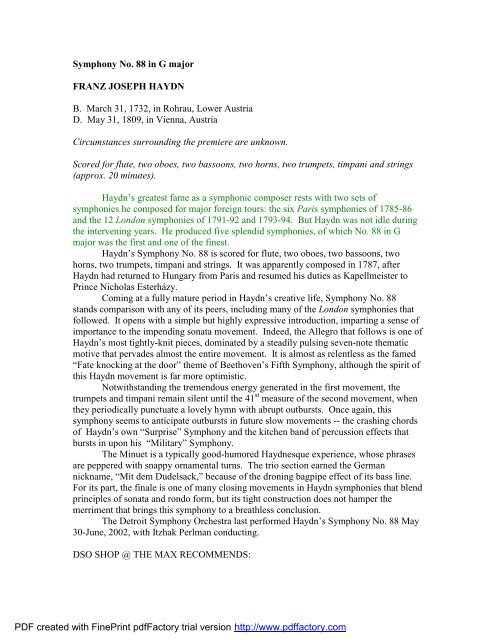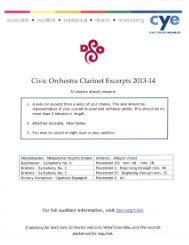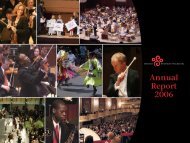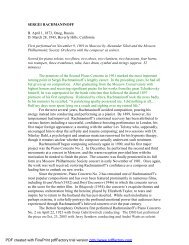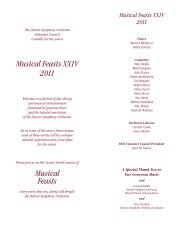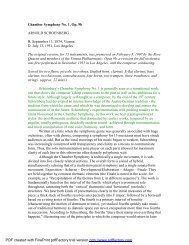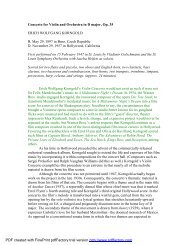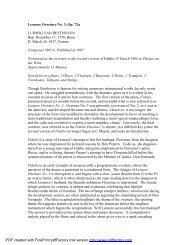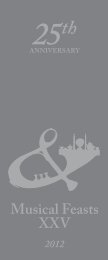Symphony No. 88 in G major FRANZ JOSEPH HAYDN B. March 31 ...
Symphony No. 88 in G major FRANZ JOSEPH HAYDN B. March 31 ...
Symphony No. 88 in G major FRANZ JOSEPH HAYDN B. March 31 ...
- No tags were found...
You also want an ePaper? Increase the reach of your titles
YUMPU automatically turns print PDFs into web optimized ePapers that Google loves.
<strong>Symphony</strong> <strong>No</strong>. <strong>88</strong> <strong>in</strong> G <strong>major</strong><strong>FRANZ</strong> <strong>JOSEPH</strong> <strong>HAYDN</strong>B. <strong>March</strong> <strong>31</strong>, 1732, <strong>in</strong> Rohrau, Lower AustriaD. May <strong>31</strong>, 1809, <strong>in</strong> Vienna, AustriaCircumstances surround<strong>in</strong>g the premiere are unknown.Scored for flute, two oboes, two bassoons, two horns, two trumpets, timpani and str<strong>in</strong>gs(approx. 20 m<strong>in</strong>utes).Haydn’s greatest fame as a symphonic composer rests with two sets ofsymphonies he composed for <strong>major</strong> foreign tours: the six Paris symphonies of 1785-86and the 12 London symphonies of 1791-92 and 1793-94. But Haydn was not idle dur<strong>in</strong>gthe <strong>in</strong>terven<strong>in</strong>g years. He produced five splendid symphonies, of which <strong>No</strong>. <strong>88</strong> <strong>in</strong> G<strong>major</strong> was the first and one of the f<strong>in</strong>est.Haydn’s <strong>Symphony</strong> <strong>No</strong>. <strong>88</strong> is scored for flute, two oboes, two bassoons, twohorns, two trumpets, timpani and str<strong>in</strong>gs. It was apparently composed <strong>in</strong> 1787, afterHaydn had returned to Hungary from Paris and resumed his duties as Kapellmeister toPr<strong>in</strong>ce Nicholas Esterházy.Com<strong>in</strong>g at a fully mature period <strong>in</strong> Haydn’s creative life, <strong>Symphony</strong> <strong>No</strong>. <strong>88</strong>stands comparison with any of its peers, <strong>in</strong>clud<strong>in</strong>g many of the London symphonies thatfollowed. It opens with a simple but highly expressive <strong>in</strong>troduction, impart<strong>in</strong>g a sense ofimportance to the impend<strong>in</strong>g sonata movement. Indeed, the Allegro that follows is one ofHaydn’s most tightly-knit pieces, dom<strong>in</strong>ated by a steadily puls<strong>in</strong>g seven-note thematicmotive that pervades almost the entire movement. It is almost as relentless as the famed“Fate knock<strong>in</strong>g at the door” theme of Beethoven’s Fifth <strong>Symphony</strong>, although the spirit ofthis Haydn movement is far more optimistic.<strong>No</strong>twithstand<strong>in</strong>g the tremendous energy generated <strong>in</strong> the first movement, thetrumpets and timpani rema<strong>in</strong> silent until the 41 st measure of the second movement, whenthey periodically punctuate a lovely hymn with abrupt outbursts. Once aga<strong>in</strong>, thissymphony seems to anticipate outbursts <strong>in</strong> future slow movements -- the crash<strong>in</strong>g chordsof Haydn’s own “Surprise” <strong>Symphony</strong> and the kitchen band of percussion effects thatbursts <strong>in</strong> upon his “Military” <strong>Symphony</strong>.The M<strong>in</strong>uet is a typically good-humored Haydnesque experience, whose phrasesare peppered with snappy ornamental turns. The trio section earned the Germannickname, “Mit dem Dudelsack,” because of the dron<strong>in</strong>g bagpipe effect of its bass l<strong>in</strong>e.For its part, the f<strong>in</strong>ale is one of many clos<strong>in</strong>g movements <strong>in</strong> Haydn symphonies that blendpr<strong>in</strong>ciples of sonata and rondo form, but its tight construction does not hamper themerriment that br<strong>in</strong>gs this symphony to a breathless conclusion.The Detroit <strong>Symphony</strong> Orchestra last performed Haydn’s <strong>Symphony</strong> <strong>No</strong>. <strong>88</strong> May30-June, 2002, with Itzhak Perlman conduct<strong>in</strong>g.DSO SHOP @ THE MAX RECOMMENDS:PDF created with F<strong>in</strong>ePr<strong>in</strong>t pdfFactory trial version http://www.pdffactory.com
Haydn, <strong>Symphony</strong> <strong>No</strong>. <strong>88</strong>, Sir Col<strong>in</strong> Davis conduct<strong>in</strong>g the Concertgebouw OrchestraAmsterdam, Pentatone 5186126.Program notes by DR. RICHARD E. RODDA.PDF created with F<strong>in</strong>ePr<strong>in</strong>t pdfFactory trial version http://www.pdffactory.com


